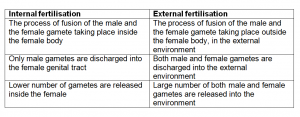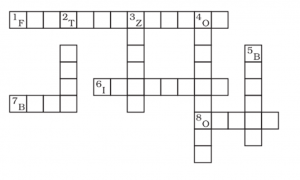NCERT Solutions for Class 8 Science Chapter 9 – Reproduction in Animals, contains solutions to various questions in Exercise for Chapter 9. At the end of the Solutions, all the keywords and Notes which are important to understand Reproduction in Animals Class 8 Chapter 9, have been explained in a simple and easy-to-understand manner. NCERT Solutions for Class 8 help to check the concept you have learned from detailed classroom sessions and the application of your knowledge.
| Category | NCERT Solutions for Class 8 |
| Subject | Science |
| Chapter | Chapter 9 – Reproduction in Animals |
Download NCERT Solutions for Class 8 Science Chapter 9 – Reproduction in Animals
NCERT Solutions for Class 8 Science Chapter 9 – Reproduction in Animals – NCERT Exercises
Question 1
Explain the importance of reproduction in organisms.
Answer 1.
The process of reproduction is very important in plants and animals. It helps to maintain the birth rate and death rate balance in organisms. It enables an organism to carry on its generation further. It also provides for genetic diversity in the new generation of offspring. If reproduction was not possible then all the species on the planet would have become extinct. It also helps in increasing the number of members of a particular species.
Question 2
Describe the process of fertilization in human beings.
Answer 2.
In human beings, fertilisation occurs by the fusion of the male gamete, the sperm produced by the testes, with the female gamete, the egg produced by the ovaries, resulting in the formation of a zygote. This process of fertilisation occurs in the ampulla of the fallopian tube of the female. This zygote starts dividing through the process of meiosis forming balls of cells which develop into tissues and organs and finally the embryo. This embryo gets embedded into the inner wall of the uterus for further development.
Question 3
Choose the most appropriate answer:
(a) Internal fertilization occurs
(i) in female body. (ii) outside female body. (iii) in male body. (iv) outside male body.
(b) A tadpole develops into an adult frog by the process of
(i) fertilization. (ii) metamorphosis. (iii) embedding. (iv) budding.
(c) The number of nuclei present in a zygote is
(i) none. (ii) one. (iii) two. (iv) four.
Answer 3.
(a) (i) in female body
(b) (ii) metamorphosis
(c) (iii) two
Question 4
Indicate whether the following statements are True (T) or False (F):
(a) Oviparous animals give birth to young ones.
(b) Each sperm is a single cell.
(c) External fertilization takes place in frog.
(d) A new human individual develops from a cell called gamete.
(e) Egg laid after fertilization is made up of a single cell.
(f) Amoeba reproduces by budding.
(g) Fertilization is necessary even in asexual reproduction.
(h) Binary fission is a method of asexual reproduction.
(i) A zygote is formed as a result of fertilization.
(j) An embryo is made up of a single cell.
Answer 4.
(a)False
(b)True
(c)True
(d)False
(e)True
(f)False
(g)False
(h)True
(i)True
(j)False
Question 5
Give two differences between a zygote and a fetus.
Answer 5.

Question 6
Define asexual reproduction. Describe two methods of asexual reproduction in animals.
Answer 6. Asexual reproduction is a type of reproduction in which there is no fusion between the male and the female gametes because only one parent is involved.
Two methods of asexual reproduction are:
1. Binary fission- It is a type of asexual reproduction in which one entity gets divided into two or more parts and then each of these parts are replicated into the original entity. It is most common in prokaryotic cells.
2. Budding- it is a type of asexual reproduction in which there is an outgrowth of a bud due to cell division at a particular site.
Question 7
In which female reproductive organ does the embryo get embedded?
Answer 7.
The embryo gets embedded in the wall of the uterus called the placenta.
Question 8
What is metamorphosis? Give examples.
Answer 8.
Metamorphosis the development of an organism from its birth to its adult life form involving drastic changes in its appearance and structure due to cell growth and differentiation.
For example- the transformation of a tadpole into a frog, the transformation of a larva into a butterfly etc.
Question 9
Differentiate between internal fertilization and external fertilization.
Answer 9.

Question 10
Complete the cross-word puzzle using the hints given below
Across
1. The process of the fusion of the gametes.
6. The type of fertilization in hen.
7. The term used for bulges observed on the sides of the body of Hydra.
8. Eggs are produced here.
Down
2. Sperms are produced in these male reproductive organs.
3. Another term for the fertilized egg.
4. These animals lay eggs.
5. A type of fission in amoeba.

Answers:
Across:
1. FERTILISATION
6. INTERNAL
7. BUDS
8. OVARY
Down:
2. TESTIS
3. ZYGOTE
4. OVIPAROUS
5. BINARY
Topics Covered in Chapter 9 Reproduction in Animals Class 8 Science :-
- Modes of Reproduction
- Sexual Reproduction
- Asexual Reproduction
Important Terms Relevant to understand NCERT Solutions for Class 8 Science Chapter 9 -Reproduction in Animals :-
Sexual reproduction: A type of reproduction beginning from the fusion of the male and the female gametes is called sexual reproduction.
Sperms: The male reproductive gametes are known as sperms.
Ova: The female reproductive gametes are known as ova or eggs.
Fertilisation: The process of the fusion of the male and the female gametes resulting in the formation of a zygote is called fertilisation.
Internal fertilisation: Internal fertilisation takes place inside the body of the female. It occurs in many animals including cows, dogs, hens etc.
In vitro fertilisation: In vitro fertilisation is the type of fertilisation in which the sperm combines with the egg outside the body of the female inside a glass test-tube. Here, the zygote is cultured for around 2-6 days and then placed inside the uterus of a woman for developing further.
External fertilisation: A type of fertilisation where the male gamete and the female gamete combine outside the female body is called external fertilisation. It is very common in aquatic animals.
Embryo: An embryo is the unborn offspring in the early stages of development.
Foetus: The stage of the embryo when all its body parts can be identified is called foetus.
Viviparous animals: Those animals which give birth to young ones are referred to as viviparous animals.
Oviparous animals: Those animals which lay eggs are known as oviparous animals.
Metamorphosis: The development of an animals from its birth to its adult stage involving drastic changes in its structure through cell growth and differentiation is known as metamorphosis.
Asexual reproduction: The type of reproduction in which only a single parent is involved is called as asexual reproduction.
Budding: A type of asexual reproduction in which the new organisms develop through a bud after cell division at a particular site is called budding.
NCERT Solutions for Class 8 Science
- Crop Production and Management
- Microorganisms: Friend and Foe
- Synthetic Fibres and Plastics
- Materials : Metals and Non-Metals
- Coal and Petroleum
- Combustion and Flame
- Conservation of Plants and Animals
- Cell Structure and Functions
- Reproduction in Animals
- Reaching the Age of Adolescence
- Force and Pressure
- Friction
- Sound
- Chemical Effects of Electric Current
- Some Natural Phenomena
- Light
- Stars and The Solar System
- Pollution of Air and Water